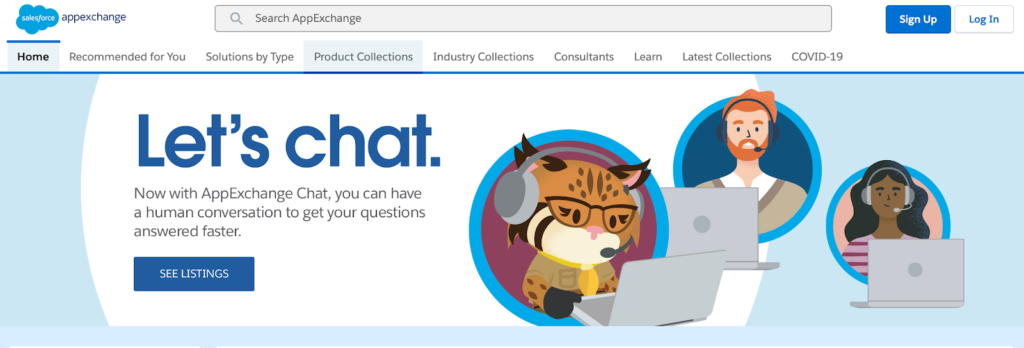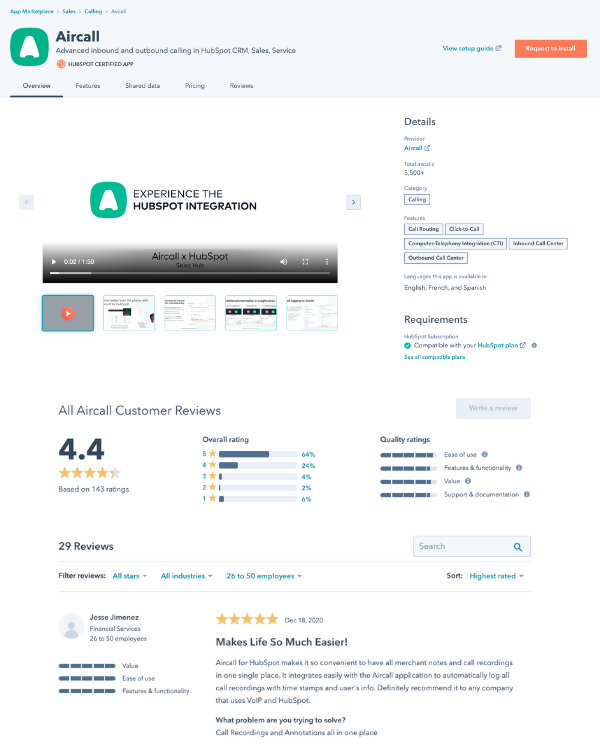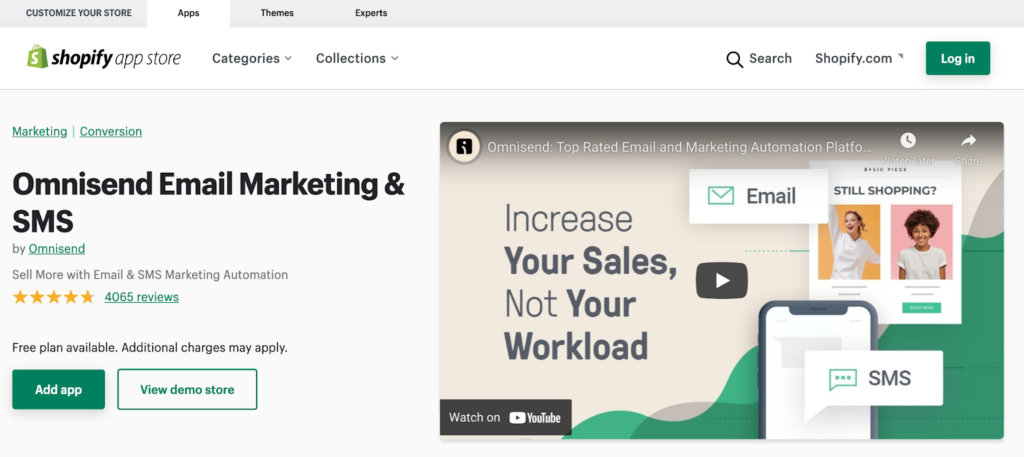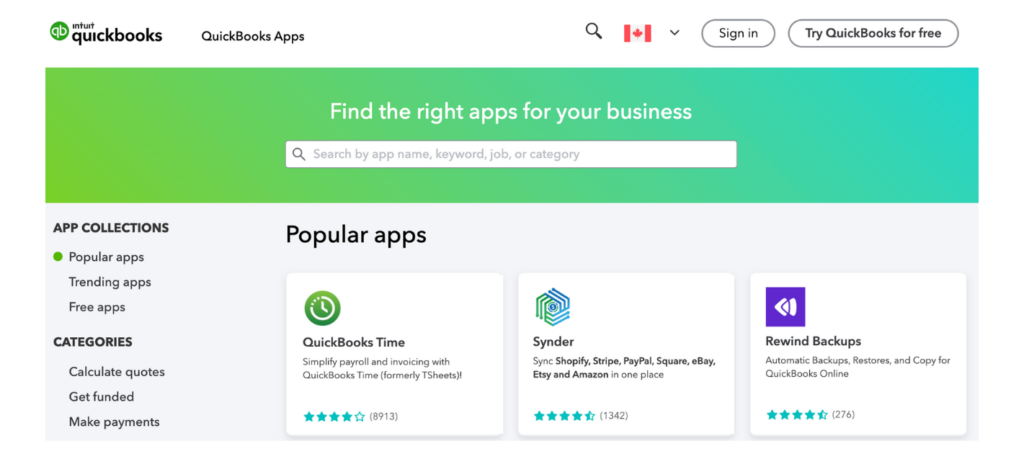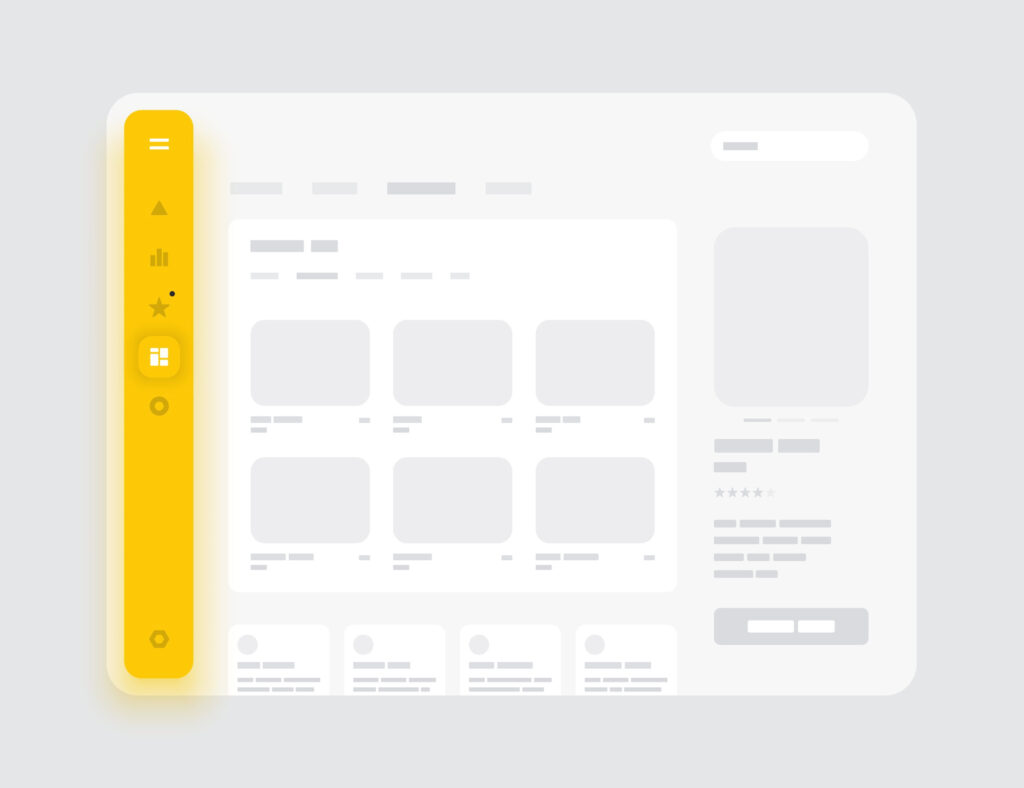B2B SaaS buyers are increasingly turning to app marketplaces. As vendors set up app marketplaces to meet this demand, roughly 30% use reviews as social proof on app marketplace listings to encourage more app installs. In part 1 of a 4-part ultimate guide to B2B tech marketplaces and reviews, we covered why app marketplaces are going mainstream, how reviews play an important role in this buying channel, and what B2B SaaS vendors are already onboard with reviews in their marketplace — with 40 examples.
In part 2, we’ll dive deep into 5 top examples of app marketplaces in B2B SaaS.
Table of Contents
What are the Best App Marketplaces in B2B SaaS?
Five of the best B2B SaaS App Marketplaces are the Salesforce AppExchange, HubSpot App Marketplace, Shopify App Store, and Google Workspace Marketplace. These are household names that do a lot of business through their respective marketplaces.
One way to look at the best B2B SaaS app marketplaces is through the lens of marketplace-driven revenue.
Forrester has found that the average cloud deal creates a 5x multiplier for partners — that is, for every dollar, the vendor collects for its product, around $5 goes to its ecosystem for services and add-on hardware and software.
Five of the best B2B SaaS App Marketplaces already realize the revenue-multiplying power of ecosystems:
- QuickBooks App Store is an important driver of Intuit’s +67% YoY Online Ecosystem Revenue — 2x the growth rate of Intuit’s overall revenue.
- Shopify’s App Store earns 4x the revenue of Shopify’s platform.
- Hubspot’s ecosystem earns 5x the revenue of Hubspot’s platform.
- Salesforce AppExchange is forecast to earn 6x the revenue of Salesforce’s platform by 2026.
- Google Cloud is forecasting 7x the revenue of its platform.
By next year, the overall marketplace market could account for 17 per cent% of the $13 trillion in B2B spend if this prediction by Forrester comes true. It’s a big market that’s getting bigger.
Here are five of the best App Marketplaces in B2B SaaS and how they leverage reviews.
Salesforce AppExchange
The Salesforce AppExchange is a marketplace for sales, marketing, and service cloud applications. It offers a wide range of apps from a variety of developers, all designed to help businesses grow.
In 2005, Salesforce introduced its AppExchange to make it easier for third-party developers and build and offer apps that are open to Salesforce customers. According to TechCrunch, the idea for a Salesforce AppExchange came from none other than Steve Jobs.
Reviews
There are 117,000+ reviews on AppExchange.
The Salesforce AppExchange was the first business app marketplace when it was started in 2005. Today, it’s the largest of its kind, so generating reviews here is important for any app listed on it.
In fact, nearly 80% percent of users who install AppExchange apps read reviews first, according to the Salesforce Developers’ Blog.
Salesforce launched Trusted Reviews in 2021 for reviewers to indicate their level of “expertise” such as Salesforce MVP, Trailhead Ranger and Top Reviewer.
The proportion of AppExchange to G2 reviews may indicate the degree of importance to Salesforce. For example, LevelJump (recently acquired by Salesforce) built its business and application on Salesforce. Therefore, it was imperative to do well on AppExchange and the Salesforce ecosystem. In contrast, Highspot has built an integration to Salesforce, but it’s not a prerequisite for a buyer to have Salesforce. In other words, the AppExchange matters more to LevelJump than it does to Highspot. As
of August 2021, LevelJump had generated 87 reviews on the AppExchange and 423 reviews on G2. Highspot, another vendor in the sales enablement space, has 87 AppExchange reviews and 810 reviews on G2 as of August 2021 — the same amount of AppExchange reviews but almost twice as many G2 reviews.
Categories
There are two main categorizations: by Product (to extend Salesforce product functionality) and by Industry (to recommend the most relevant apps to companies in your industry).
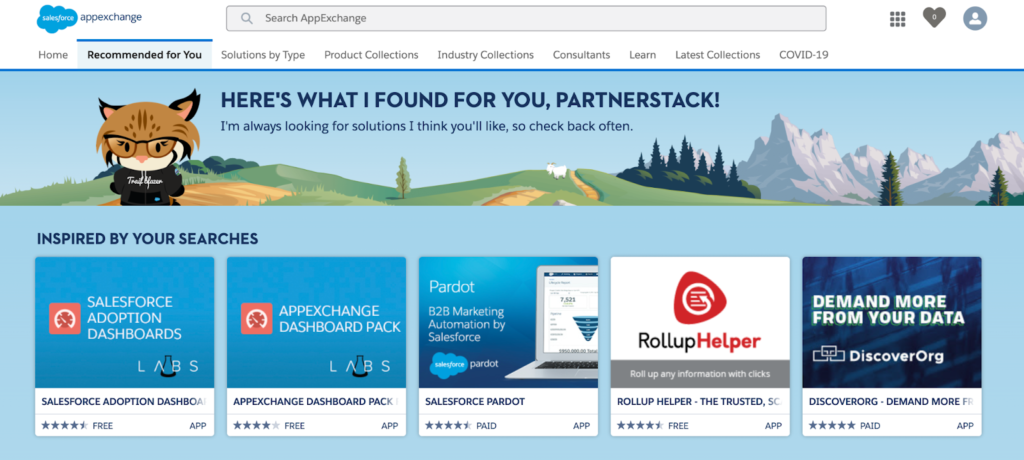
Products Listed
4,600+ apps listed. According to Salesforce, as of 2018, 71% of Salesforce customers actively use apps from the AppExchange. In January 2022, Salesforce achieved 10 million app installs on AppExchange.
Monetization Methods
Revenue share on app purchases (Revenue share as of FY22: 15% for apps with a dependency on Salesforce technology and 25% for apps without a dependency on Salesforce technology)
Sorted by
It’s sorted by sponsored apps and then by most popular apps.
Primary Market
All buyers
Extra Info
Salesforce launched Trusted Reviews in 2021 for reviewers to indicate their level of “expertise” such as Salesforce MVP, Trailhead Ranger and Top Reviewer.
Blog
Read the AppExchange and the Salesforce Ecosystem on Medium.
About
To learn more about Salesforce AppExchange, visit the AppExchange Overview page.
FAQs
Wayback Look
For fun, here’s the first Wayback Machine recording of appexchange.salesforce.com in December 2010.
Vendor example – ZoomInfo
ZoomInfo has an impressive presence on the Salesforce AppExchange, presumably a key source for their primary buyer (Sales) to turn for solutions that could enhance their CRM platform. At the time of writing, ZoomInfo has generated 347 reviews and a stellar 4.6 average rating (which is remarkably high given that review scores on app stores tend to be lower than on review sites).
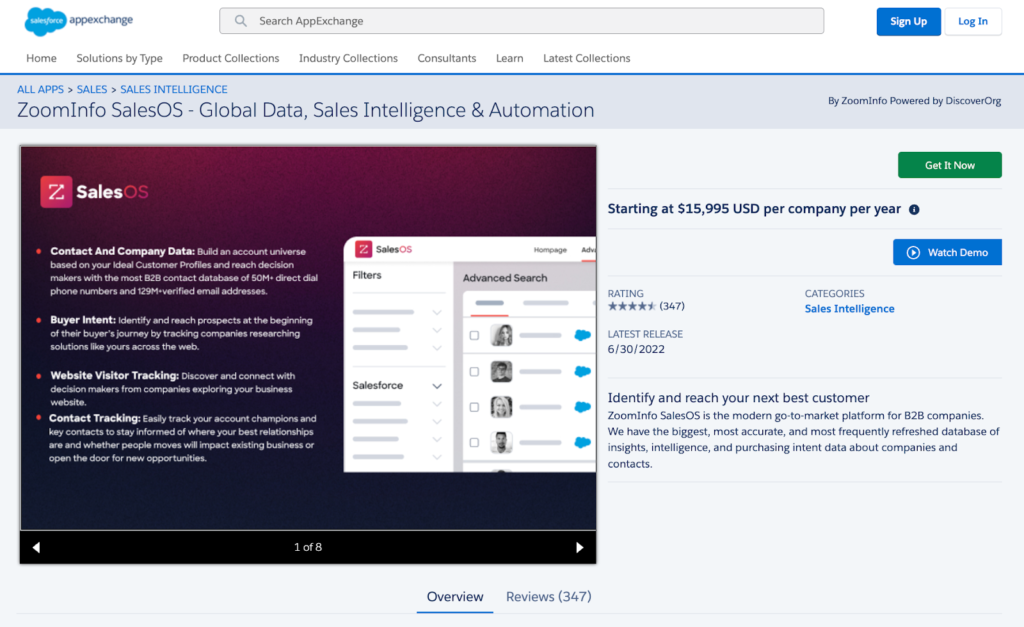
HubSpot App Marketplace
The HubSpot App Marketplace is a marketplace for marketing, sales, and service applications. It offers a wide range of apps from a variety of developers, all designed to help businesses grow.

Origin story
Back in 2011, HubSpot announced the launch of their HubSpot App Marketplace as the world’s first application marketplace for marketing software. At the time, HubSpot had “more than a dozen approved applications” that are being used by more than 1,000 companies and 3,000 app installs.The company also announced that the App Marketplace would enable developers to build apps that seamlessly integrate with Hubspot software.
In the launch announcement, Dharmesh Shah, HubSpot Co-Founder, added, “Successful software companies offer ways for third parties to extend the value to the end user. Facebook has the Facebook platform and Salesforce.com has the AppExchange. At HubSpot, we believe that the best way to address customer needs is to open our platform and collaborate with developers that share our passion for marketing.”
Overview
Fast forward to today and the HubSpot App Marketplace now has more than 1,250 companies in its App Partner Program that had more than 1,000,000 app installs on the HubSpot App Marketplace from HubSpot’s 167,000+ companies in their customer base.
While HubSpot is growing fast, its app ecosystem is growing faster. The ecosystem that supports HubSpot customers with add-on products and services is more than five times bigger than HubSpot today and is expected to be more than six times bigger by 2024.
Reviews
The vendors in the HubSpot App Marketplace have thousands of reviews (with an average score of 4 out of 5 stars).
While proactive review generation for your HubSpot app listing is a good idea, note that HubSpot will automatically send a request to users to review the app. The request will be sent to the user that installed the app 30 days after installation.
Also, HubSpot has also said that apps must have three or more reviews for the aggregated star ratings and quality ratings to be visible.
Learn how to receive and manage ratings and reviews of apps in the App Marketplace.
Monetization Methods
According to HubSpot documentation, “We do not charge developers a fee to list their apps in the App Marketplace, nor a fee for installs generated through the App Marketplace.”
Sorted by
By most installed.
Primary Market
Small and medium-sized businesses.
Categories
The main categorization is by function: Marketing, Sales, Customer Service, Productivity, and Finance (with sub-categories within each).
Products Listed
Extra Info
Read Why HubSpot’s Building a Centralized Platform, according to HubSpot’s VP Platform Ecosystem, Scott Brinker.
Blog
HubSpot Developer Blog – App Partner Program posts
FAQs and About the HubSpot App Marketplace and
See the Partner App page for the HubSpot App Marketplace
Vendor example: Aircall
Aircall has a multi-faceted partnership with HubSpot. Both companies are listed on each other’s app marketplace and offer exclusive deals to add the other’s software. On HubSpot’s listing on the Aircall marketplace, Aircall customers get 20% off HubSpot. In return, HubSpot is promoting an offer to HubSpot customers to “Sign up for an Aircall annual contract and get 2 months free plus a complimentary 1-hour consultation with a preferred Aircall + HubSpot Solutions Partner to help you get the most out of your integration.”
Ecosystems = Growing Better Together.@Aircall and @HubSpot are teaming up to offer businesses custom expert guidance and exclusive discounts on software.
— Scott Brinker (@chiefmartec) October 13, 2022
Learn more about our partnership, and how we’re empowering businesses to grow better: https://t.co/L3Z7n5arqQ #martech
Shopify App Store
The Shopify App Store is a marketplace where merchants using the Shopify platform can find, choose, and install apps to enhance their online store. These apps offer marketing tools, customer support options, and inventory management solutions. By integrating with the Shopify platform, these apps allow merchants to streamline their operations and improve the overall functionality of their e-commerce store.
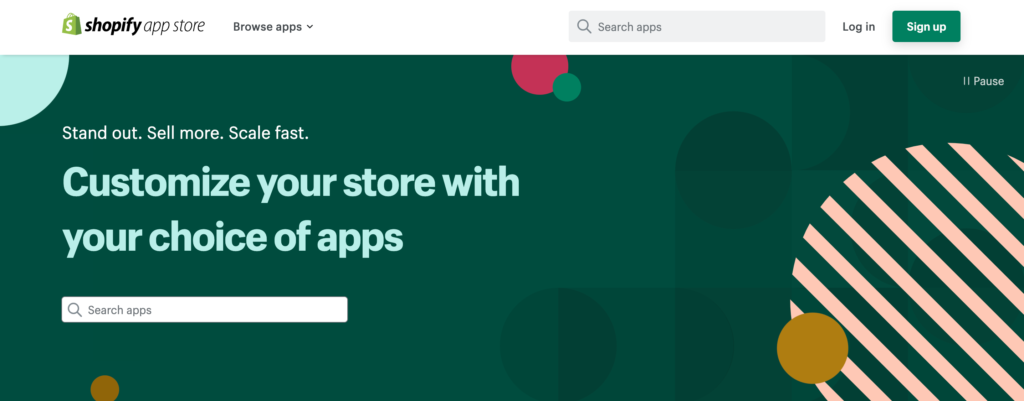
Origin story
Shopify’s open platform and open API have always been a point of pride for the company. According to Shopify article on The Story of the New Shopify App Store, their founders believed that merchant should own their (Shopify) store and do what they want with it, which is why Shopify has always had an open platform and an open API. The first iteration of the Shopify App Store was launched in 2009 with less than a dozen apps, as Shopify tells it.
Overview
Today, the Shopify App Store is a collection of 7,800+ apps that extend the functionality of a Shopify store.
Reviews
If your app is listed on the Shopify App Store, then positive reviews can make your app appear higher in search results or on category pages. Reviews are also an “important part of getting featured on the Shopify App Store.” according to Shopify.
The exact number of reviews on the Shopify App Store is unknown, but its many thousands, as one vendor, Omnisend (email marketing software), has over 4,000 reviews (other popular Shopify apps also have thousands of reviews).
Shopify made a free app called “Product Reviews” that allows Shopify customers to add a customer review feature to their products.
Monetization Methods
Revenue share on app purchases.
According to Shopify, “Developers who build for the Shopify App Store will now pay 0% revenue share for the first $1M they earn annually on the platform starting on August 1. That’s down from 20%. The $1M benchmark resets annually. The same 0% revenue share model will also be available to Theme Store developers.”
TechCrunch added to this Shopify announcement, “And when Shopify’s revenue share kicks in, it will now only be 15% of “marginal” revenue. That means developers will pay 15% only on revenue they make that’s over the $1 million mark.”
For official guidance from Shopify, see Revenue share for Shopify App Store developers.
Sorted by
By most relevant (most installed and newest are also options)
Primary Market
eCommerce merchants
Categories
There are 9 main categories: Sourcing and Selling Products, Store Design, Merchandising, Marketing, Conversion, Fulfillment, Shipping and Delivery, Customer Service, and Store Management.
Blog
See the Shopify Partners Blog.
About
To learn more about the Shopify App Store, visit https://shopify.dev/apps.
FAQs
See Shopify FAQs.
Wayback Look
Here’s the first Wayback Machine recording of the Shopify App Store back on June 12, 2009.
Reviews as a Service (RaaS) option
Shopify made a free app called “Product Reviews” that allows Shopify customers to add a customer review feature to their products.
Vendor example: Omnisend
Omnisend is an Ecommerce Email Marketing and SMS Platform. So what better app marketplace for Omnisend than that of Shopify, the all-in-one e-commerce platform (with a basic email solution)?
Omnisend has generated more than four times as many reviews on the Shopfiy App Store than Shopify Email and has a 4.7 rating to Shopify Email’s 4.1.
QuickBooks App Store
The QuickBooks App Store is a marketplace for businesses to find and add apps that integrate with their QuickBooks software. These apps can streamline invoicing, expense tracking, inventory management, and more. With various options available, businesses can customize their QuickBooks experience to best fit their needs. The App Store also offers resources for app developers, allowing them to showcase their products and reach potential customers. Whether a small business owner or a larger enterprise, the QuickBooks App Store can help make managing your finances easier and more efficient.

Origin story
In 2013, Intuit unveiled an app marketplace, which at the time was apps.com. The marketplace would help business owners to help find apps that extend QuickBooks Online. Apps.com would also enable third-party developers to build apps to enhance the accounting platform’s app ecosystem.
Reviews
The QuickBooks App Store has thousands of reviews. In the words of Intuit, “Reviews and ratings impact your app’s ranking on the QuickBooks App Store.”
Intuit makes special note to avoid generating reviews in batches as their system may flag them as fraudulent; an unusual quirk on their approach to review approval so do take note.
While Intuit (QuickBooks) doesn’t offer review-as-a-service, they encourage app vendors to get reviews on the QuickBooks App Store and provide tips and tricks to do so on the Intuit Developer site.
Note that Inituit’s review incentive policy precludes vendors from providing reviewers with a direct financial incentive of any form for writing a review, including free services, money, or other direct compensation. However, “potential reviewers may be invited to participate in a giveaway or sweepstakes program.”
For an example of a vendor that ran a successful QuickBooks App Store review generation campaign with a giveaway contest, see the Acuity Scheduling (now part of Squarespace) example in the post, A Practitioner’s Guide to B2B SaaS Reviews: How Vendors Can Generate, Leverage, and Measure Reviews.
For more review generation tips from Intuit, see the blog post, Getting customers to write reviews for your app.
Monetization Methods
There is no fee or revenue share to be on QuickBooks App Store
Sorted by
Undisclosed. It appears as though it’s sorted by a combination of number of reviews and review score.
Primary Market
Small and medium-sized businesses.
Categories
There are 15 main categories:
- Calculate quotes
- Get funded
- Make payments
- Manage customers
- Manage human resources
- Manage projects
- Perform analytics
- Prepare taxes
- Receive payments
- Run payroll
- Send invoices
- Sync data
- Track expenses
- Track inventory
- Track time
Products Listed
Hundreds of apps.
Visitors
4.2 million QuickBooks Online small business users.
Blog
See the Intuit Developer blog.
About
Learn more on Intuit’s Market Your App page.
Wayback Look
Here’s the first Wayback Machine recording of the QuickBooks App store back in July 24, 2013.
Vendor example – Rewind
Rewind software helps back up, copy, and restore your SaaS and cloud data. Rewind has backup solutions for several third-party software solutions, including QuickBooks Online, making it a natural for the QuickBooks App Marketplace.
Rewind has a 4.6 rating on 371 ratings on the QuickBooks App Marketplace.
Google Workspace Marketplace
The Google Workspace Marketplace is a one-stop shop for businesses to discover and install integrated productivity apps for their team. These apps work seamlessly with the Google Workspace tools, such as Gmail, Calendar, and Drive. With over 700 solutions from top providers, users can easily find the best fit for their needs. Not only can these apps enhance team collaboration and efficiency, but they also offer robust security measures to protect important business data. The Google Workspace Marketplace offers a wide range of options for businesses of all sizes and industries, from project management and CRM software to video conferencing tools.

Origin story
in 2010, Google opened the Google Apps Marketplace. Like many other app marketplaces, Google’s reason to launch an an app marketplace was similar to many others: to make it easy to discover, deploy and manage cloud applications that integrate with their software, Google Apps. Some of the first apps in the marketplace were made by Intuit, Appirio, and Atlassian.
In the Google Apps Marketplace launch announcement, Google said that there was demand for a range of business applications that Google has no particular expertise in making, and that the Google Apps Marketplace would allow for an easier way to integrate more business applications into Google Apps.
Overview
Google Workspace was originally known as Google Apps, then Google Apps for Work, then G Suite, and finally Google Workspace (2020 to present). One common thread throughout the years has been Google’s message that its apps are designed to provide a single, unified experience. For example, when introducing G-Suite, TechCrunch reported Google saying “(we) wanted to make it clear to potential enterprise users that this is a unified collection of tools and not simply a set of individual offerings.” Later when introducing Google Workspace, this idea of Google Apps as a single, unified experience was re-iterated.
Reviews
Reviews on Google App Marketplace provide social proof on app listings, and can help more buyers discover an app through the Google Workspace Homepage or the Top Rated charts.
To appear on the Google Workspace Homepage, Google Workspace for Developers says, “App listings featured on the homepage are algorithmically selected based on a combination of rankings, reviews, install performance, and other factors.”
While many business software review sites encourage reviewers to go into more detail to provide a thorough review, on Google App Marketplace there is an upper limit of 2,500 characters per review (roughly 500 words).
Also unlike business software review sites, Google doesn’t verify user reviews and ratings. However, if a review violates their policies, Google says that it will be removed and that users can also report abusive reviews.
On Google Workspace Admin Help, they share tips and guidelines and rating and review policies.
Monetization Methods
There does seem to be a revenue share model in place. While I’m unable to find the details, CNBC reported on September 21 2021 that “Google is reducing the amount of revenue it keeps when customers buy software from other vendors on its cloud marketplace… cutting its percentage revenue share to 3% from 20%, according to a person familiar with the matter who asked not be named in order to talk about internal policies.”
Sorted by
On a category page, apps are sorted by most popular (i.e from most installs to least installs).
Categories
There are four main categories, each with sub-categories:
- Editor’s Choice – sub-categories include Work from everywhere, business essentials, etc.
- Top Charts – sub-categories include Most popular, top rated
- Categories – sub-categories include Business Tools, Productivity, etc.
- Works with Google Products – sub-categories include Works with Drive, Works with Gmail, etc.
Products Listed
More than 5,300 third-party apps.
Visitors
6 million businesses are paid users of Google Workspace.
Blog
About
FAQs
Google Workspace Marketplace FAQ.
Vendor example – Streak CRM
There are hundreds of CRM platforms, which has led to niche CRM solutions. Streak is one such tool, as it’s CRM for Gmail. Streak CRM is listed in Google’s Business Essentials category,
Streak CRM has a 3.9 rating and 1,468 reviews on 810,643 app installs.
Conclusion
App marketplaces are a great way for B2B SaaS companies to create additional revenue streams and multiply their existing customer base. Intuit, Shopify, Hubspot, Salesforce, and Google are all examples of companies that have built successful marketplaces. Forrester has found that on average, a cloud deal creates a 5x multiplier for revenue – meaning that for every dollar the vendor collects for its product, around $5 goes back into the ecosystem through services and add-on hardware/software purchases. The world’s largest software companies have already realized the revenue-multiplying power of ecosystems – and you should too.
To learn more about app marketplaces, read part 3 in our app marketplace series where we’ll explore the three hyperscaler cloud marketplaces: AWS Marketplace, Microsoft Azure Marketplace, and Google Cloud Marketplace.
Author
-

I'm the Founder and Editor-In-Chief of B2B SaaS Reviews and the Director of Demand Generation at PartnerStack, the leading platform for partner management and affiliate marketing in B2B SaaS. My experience spans several notable B2B SaaS companies, including Influitive (Advocate Marketing), LevelJump (Sales Enablement, acquired by Salesforce), and Eloqua (Marketing Automation, acquired by Oracle). I hold a Bachelor of Commerce in Marketing Management from Toronto Metropolitan University and a Master of International Business from Queen's University, with academic exchanges at Copenhagen Business School and Bocconi University.

